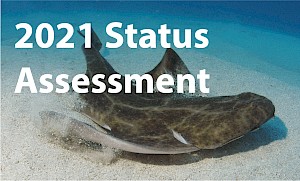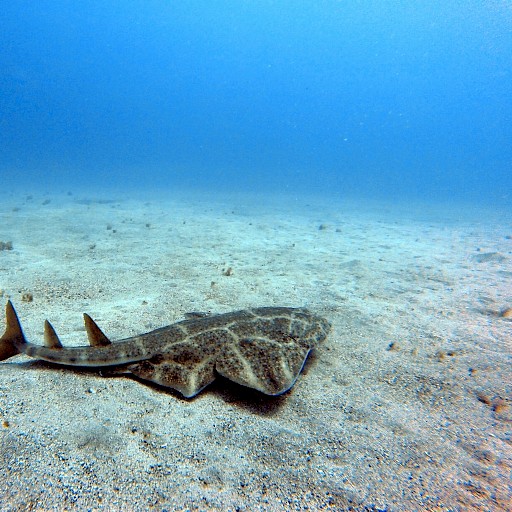Angel shark
Common Name: Angel shark
Scientific Name: *Squatina squatina
Description: Squatina squatina, the angelshark, is a species of shark in the family Squatinidae (known generally also as angel sharks), that were once widespread in the coastal waters of the North-East Atlantic. Well-adapted for camouflaging itself on the sea floor, the angelshark has a flattened form with enlarged pectoral and pelvic fins, giving it a superficial resemblance to a ray. It measures up to 2.4 m (7.9 ft) long.
OSPAR Regions where it occurs: II, III, IV
OSPAR Regions where under threat and/or in decline: II, III, IV
What is the latest status of the angel shark?
 The status assessment describes the latest changes in distribution, abundance and range of the feature, as well as any changes in the threats and pressures impacting the feature. The status assessments are updated regularly and inform OSPAR’s consideration of the effectiveness of the measures and actions that have been adopted and implemented by Contracting Parties.
The status assessment describes the latest changes in distribution, abundance and range of the feature, as well as any changes in the threats and pressures impacting the feature. The status assessments are updated regularly and inform OSPAR’s consideration of the effectiveness of the measures and actions that have been adopted and implemented by Contracting Parties.
Key message
Angel shark remain a rare species across its biogeographical range, including OSPAR regions II–III–IV. It is a very sensitive species that has declined severely in the OSPAR Area and adjacent waters (e.g. Mediterranean Sea). This decline occurred during the 20th century, with Angel shark lost from large parts of the OSPAR Area from the 1960s to the 1990s. Their low productivity and limited movements means that any perceptible improvement in status would only occur over a decadal time-frame. This is still the case in the current assessment and, whilst there is no evidence of further deterioration, there is no sign of improving status.
For more information please visit our latest status assessment
Distribution
The biogeographical range of angel shark extends from Scotland and southern Scandinavia to Northwest Africa, the Canary Islands and the Mediterranean Sea (where it may enter the Black Sea close to the Sea of Marmara). This area covers OSPAR Regions II-IV. The geographic extent of angel shark has declined by an estimated 58%, with refuge populations in Welsh and Irish waters (OSPAR Region III) and outside the OSPAR Area (Canary Islands and parts of the Mediterranean Sea) (Lawson et al. 2020).
In OSPAR Region III, Tralee Bay, Clew Bay, Cardigan Bay and parts of the Bristol Channel have been identified as important for angel shark (Shepherd et al. 2019, Barker et al. 2020).
For more information please visit our latest status assessment
Measures that address key pressures from human activities or conserve the species/habitat
In 2008, ICES advised that angel shark should receive the highest protection possible. It has since been listed as a prohibited species in EU fishery regulations, thus minimising mortality from commercial fisheries. EU Regulation 2015/812 (EU 2015a) requires all angel shark discards to be recorded. Some nations (e.g. UK, Spain) have protected angel shark under national legislation, thus affording protection from other activities (e.g. recreational fishing).
For more information please visit our latest status assessment




